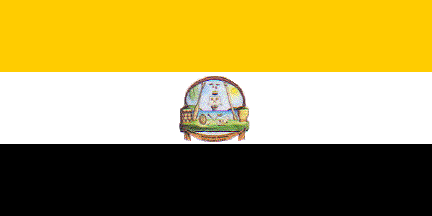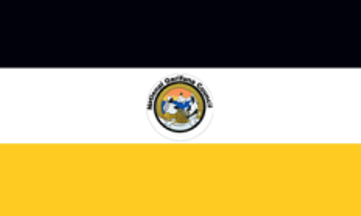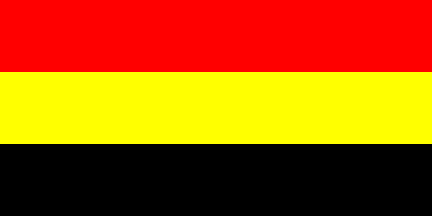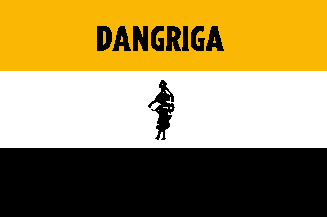 image by Ivan Sache, 27 April 2008
image by Ivan Sache, 27 April 2008
Last modified: 2020-05-13 by rob raeside
Keywords: america | central america | honduras | belize | garifuna | gariganu | dangriga |
Links: FOTW homepage |
search |
disclaimer and copyright |
write us |
mirrors
 image by Ivan Sache, 27 April 2008
image by Ivan Sache, 27 April 2008
See also:
About 2 days ago on CNN I just saw a little report on the
Garifundio (or something quite similar, I couldn't write it down
at that moment) people. If I understood well, I didn't see it
complete, they are descendents of Africans brought to America.
Again, If I understood well, they live in Belize. Of course, the
interesting thing is that they have a flag. (from up to down):
equal stripes yellow, white, black. Proportions, as always in
moving flags, were a little difficult to tell, but it seemed to
me that the flag was not very "long" (as 1:2) I would
rather say it looked like 3:4.
Nicolas Rucks, 3 April 2000
It's 'Gari'funa' according to State of the Peoples', by Marc
S. Miller (ed), Boston, 1993 :
Gari'funa of Belize.
The Gari'funa, also known as Caribs or Black Caribs, are not
native to Central America but can be classified as an Indian
element on the basis of their genetic makeup and their use of a
language indigenous to the Americas. Of mixed African and Carib
Indian descent, the Gari'funa originated on St. Vincent Island in
the Lesser Antilles. Gari'funa were deported by the British to
Honduras in 1797 and reached Belize during the early nineteenth
century. Gari'funa are concentrated in six villages in southern
Belize near the Caribbean coast - Dangriga (formerly Stann
Creek), Hopkins, Georgetown, Seine Bight, Punta Gorda, and
Barranco. The British established agricultural
"reserves" on the outskirts of Dangriga and Punta Gorda
during the 1930s for subsistence-oriented farmers and fishing
people. In recent decades, the number of Belize Gari'funa has
remained relatively stable. The most numerous Indian group in the
country, they number about 11,000, accounting for 8 % of the
population. Some Gar?funa are migrating from coastal villages.
This trend reaches throughout Belize and beyond to large
Gari'funa communities in Los Angeles, Houston, New Orleans, and
New York. However, the homelands remain strong Gari'funa
territory.
Gari'funa of Honduras.
Gari'funa speakers occupy the Caribbean coast between southern
Belize and northeast Honduras, plus a small enclave at Pearl
Lagoon, Nicaragua. Of the 54 Gari'funa settlements in Central
America, 44 are along the coast of northern Honduras. Gari'funa
are the majority rural people of the country's northern coastal
fringes. Official population estimates for Honduran Gari'funa are
between 70,000 and 80,000, but Gari'funa leaders often suggest a
figure of 200,000 to 300,000. A 1988 Honduran language census
lists 27,745 Gari'funa speakers, certainly an undercount.
Gari'funa are unified and characterized primarily by language and
rituals. Women normally dominate agriculture and food
preparation, which centers on bitter manioc. Men engage in
fishing-related activities and wage labor away from the villages.
Although the distinctive Gari'funa culture, including dance, folk
stories, songs, death, and rituals, remains strong in the home
beach lands, out-migartion throughout Honduras and abroad is
increasing. Maintaining the language and traditions is more
difficult away from the villages. In addition, ladino
encroachments onto traditional Gari'funa lands present the
possibility of cultural dissolution.
Jarig Bakker, 3 April 2000
Data from "The Ethnologue" at <www.sil.org>:
GARÍFUNA (CARIBE, CENTRAL AMERICAN CARIB, BLACK CARIB) [CAB]
12,274 in Belize (1991 census); 75,000 in Honduras (1995 UBS);
16,700 in Guatemala (1990 SIL); 1,500 in Nicaragua; 94,500 in all
countries. Stann Creek and Toledo along the coast. Arawakan,
Maipuran, Northern Maipuran, Caribbean. They speak Creole as
second language. Dictionary. English-oriented orthography used in
Belize, Spanish-oriented in Guatemala. NT 1983-1994. Bible
portions 1847-1968.
Nicolas Rucks, 7 April 2000
The website
of the National Garífuna Council of Belize has a detailed
description of the flag: "The Garifuna flag consists of
three horizontal strips of black, white and yellow, in that
order, starting from the top. This flag has long been accepted
internationally as the flag of the Garifuna Nation and the
colours have been used in any forum where Garifuna people assert
their Garifuna identity. The flag of the National Garifuna
Council is identical to the Garifuna flag with the addition of
the NGC logo set in a white circle in the center.
This flag represents an evolution that commenced with the Carib International Society (CIS) whose flag was
made up of horizontal strips of red, yellow and black. Red
(funati) stood for the blood of the Garifuna, black (würiti) the
skin of the Garifuna and yellow (dumari) the food of the
Garifuna. T.V. Ramos added the strip of white (haruti) in the
middle, substituting it for the red, when he formed the Carib
Development Society (CDS). Carib International Society, as the
name implies, was international in scope and its development
appears to have been facilitated by the convergence of Garinagu
from the various countries in places like Puerto Barrios where
they flocked in search of employment with the United Fruit
Company. The area of operations of the Carib Development Society,
on the other hand, was limited to Belize although the influence
of its initiatives spread far beyond the borders of Belize and
laid the foundation for the later emergence of its successor, the
National Garifuna Council."
The author of the notice gives an interpretation of the colours,
stating that there are no written source for that
"What is the significance of the colours of the Garifuna
flag? This question has been asked quite frequently and some
attempts have been made to answer it although I am not aware of
any written explanation. I will now try to piece together what I
have heard, with the hope that this will evoke some reaction that
can contribute to a full and complete documentation of the
significance of the colours. It should also be noted that it is
people who give meaning to symbols. We, therefore, have the
option of expanding on whatever meanings have been handed down to
us by the originators of the CIS and CDS flags.
Black - The black strip, which is located at the
top, represents the black ancestry of the Garifuna people. The
people have always acknowledged the African input into what
became the Garifuna people, a phenomenon that occurred in St.
Vincent starting in the seventeenth Century.
This colour, at another level, recognizes the hardships and
injustices that the people have had to endure, their struggles
for survival and the odds that they have had to overcome in the
course of their history. Apart from the experience of the Middle
Passage, which we share with other black people of the Americas,
there was the imprisonment on Balliceaux, the exile from our
Vincentian homeland after the so called Carib Wars and the replay
of the Middle Passage in the form of the mass forced relocation
to Central America.
Tough though these experiences have been, they helped to
strengthen our spirit and shape our spirituality which is based
on the principle of reciprocity captured in the Malí song in the
words “Aura buni Iyaya waü, amürü nuni” – I for
you, Grandmother, and you for me.
Yellow - The yellow strip at the bottom of the
flag symbolizes the other half of the ancestry of the Garifuna
– the Amerindians or Yellow Caribs as they were referred to
by Europeans. These were actually a mixture of Caribs and Arawaks
and formed the host community in which the fusion of Africa and
South America took place to give rise to the emergence of the
Garinagu as a distinct group indigenous to the circum-Caribbean
region.
In contrast to the hardships experienced in the course of
history, the yellow symbolizes the hope and prosperity. Yellow is
the colour of grated cassava, which is further processed to make
ereba, one of our staple foods. It is the colour of cassava
juice, a colour that is further brought out in the process of
turning it into dumari, an additive for enhancing sauces, soups
and stews. (It seems to have been an identifying feature of
Garifuna people as it is the “tumali” that is referred
to in the racial slur “Salt head Kerub, tumali water”).
Yellow is also the colour of the rising sun, which brings new
promise and much hope for a better life. Yellow, therefore,
represents hope, plenty and prosperity, as well as the
Carib/Arawak input into the Garifuna identity.
White - The white strip, located in the middle
between the black and the yellow, reminds us of the role of the
white man (Europe) in the history and formation of the Garifuna
people – the forcible removal and enslavement of the
African, the seizure of Garifuna land, which precipitated the
Garifuna resistance, and the forcible removal of the people from
St. Vincent. Even after the arrival and dispersal in Central
America, it was still necessary to deal with the white man.
At another level, white symbolizes the peace that has eluded the
Garifuna people for most of their turbulent history - the peace
for which they continue to yearn."
Finally, the author of the notice mentions a flag proposal:
"It would be remiss of me not to mention an attempt made by
Ruben Reyes to propose a flag for the Garifuna Nation. The
colours are essentially the same. He also proposes a logo set in
a shield in the center. I believe that it is a good effort and
that the various country Garifuna organizations should respond to
him with a view to its possible adoption."
Ruben Reyes' proposal is for sale at the Internet
store of Garinet.
We show in this page, two flags with the black stripe either on
top or on bottom. As stated by the author of the notice, both
combinations exist: "The relative position of the colours
needs to be clarified or agreed. It is clear that the white strip
is always in the middle. The problem is with the black
and yellow. I have referred to the black as being on top partly
because of the location on the samples I looked at when I was
writing this and partly because the colours have always been
referred to as “black, white and yellow” and we
normally start at the top. However, I have since seen some
examples in which the black is at the bottom, including the
proposal from my cousin, Ruben Reyes."
The website
also contains an historical account of the Garifuna:
"Traditional Garifuna communities are mainly found along the
Caribbean Coast of Belize, Honduras and Nicaragua. Out of an
estimated 500,000 Garinagu world-wide, there are today about
15,000 Garinagu in Belize (about 7 % of the total population). In
Guatemala there are an estimated 4,000 Garinagu and in Honduras
the population is around 300,000. Garifuna communities are also
found in the USA in Los Angeles, Chicago, New York and New
Orleans.
Garinagu (plural of Garifuna) or Black Caribs, are descendants of
two ethnic groups, Carib Indians and Black Africans, that lived
on the island of St. Vincent.
Arawak Indians, also called Yurumei, the original inhabitants of
St. Vincent, were invaded and conquered by Kalipuna (Carib)
Indians, a tribe from mainland South America. The Arawak men were
killed and the warriors took the women as wives and the Carib
Indians originated as a mixture of these people.
Around 1635 two Spanish ships carrying Black Africans destined
for slavery, to the West Indies shipwrecked near St. Vincent.
Survivors escaped and swam ashore to St. Vincent where they
settled and lived amongst the Carib Indians.
Over the next 150 years, the two groups intermixed and the
Garifuna ethnic group also called Black Caribs was formed. By
1750 the Black Caribs were the dominant population of St. Vincent
and quite prosperous. French settlers lived on the island as
well.
The Black Carib men hunted and fished while the women did most of
the farming. The Black Caribs also traded with nearby islands:
tobacco and baskets for arms and European manufactured goods. In
1763 the British invaded the island trying to take over land from
the Black Caribs to plant sugarcane. This struggle for land
resulted in the Black Caribs trying to establish independence and
control of the island. They were supported by the French with
whom they did considerable trading and many years of battles
between the Caribs and the British ensued. After losing a major
battle in 1795, the French and the Black Caribs finally
surrendered and the British took over the entire island.
The British hunted down the Black Caribs, burned their houses and
killed hundreds. Early in 1797 over 4000 Black Caribs were taken
prisoner and sent to the Island of Baliceax where over half of
them died from diseases like yellow fever and malaria. In 1798
the rest were exiled to the Island of Roatan, an island off the
coast of Honduras. From Roatan the Black Caribs migrated to the
mainland of Honduras (Truillo) and settled all along the
Caribbean coast of Belize (then British Honduras), Guatemala,
Honduras and Nicaragua.
According to legend, the first Garifuna arrived in British
Honduras on November 19, 1802. Today this day is a national
holiday and the arrival of the Garinagu is celebrated allover
Belize with drumming, dancing and pageantry in Garifuna
communities."
While we have written and iconographical sources for the
Garifuna flag(s), there is no source available for the "Dangriga Flag".
Ivan Sache, 27 April 2008
garif.gif) image by Fred Drews, 25 December 2011
image by Fred Drews, 25 December 2011
 image by Fred Drews, 6
April 2020
image by Fred Drews, 6
April 2020
.gif) image by Fred Drews, 6
April 2020
image by Fred Drews, 6
April 2020
be.gif) image by Fred Drews, 6
April 2020
image by Fred Drews, 6
April 2020
da.gif) image by Fred Drews, 6
April 2020
image by Fred Drews, 6
April 2020
 image by Ivan Sache, 27 April 2008
image by Ivan Sache, 27 April 2008
 image by Jaume Ollé , 15 April 2000
image by Jaume Ollé , 15 April 2000
Garifuna or Garifundio must be the same people as Gariganu.
Gariganu have their own flag , dark yellow, white and black with
central emblem in the white, and black letters in the upper
stripe. I don't know what is the meaning of the word DANGRIGA.
According to source, Gariganu are old slaves that are in Belize
since 1832.
Jaume Ollé, 15 April 2000
Dangriga is the name of a southern Belize town near the
Caribbean coast, formerly Stann Creek. It means "standing
water" in Garifuna language, population about 10,000.
Dangriga is the cultural center of the Garifuna.
Jarig Bakker, 16 April 2000
I checked with a professor friend who recently returned from
several months in Belize. His response was: "Garifuna
were NEVER slaves. They descend from a slave ship rebellion
and were marooned and kept their African culture in tact and
mixed with Caribe Indians to form Garifuna culture and language.
Dangriga is the town in Belize that is the center of Garifuna
Culture."
Kevin McNamara, 26 April 2000
 image by Blas Delgado Ortiz, 6 September 2001
image by Blas Delgado Ortiz, 6 September 2001
Reading the September 2001 issue of National Geographic I
reached the article about the Garífuna. One of the pictures
shows a partially hidden triband paste to a green board with the
written title "The Garifuna Flag". It is a black-white-
light gold triband in that particular order. The flag at top is
exactly the inverse. Beside each band it reads:
black band - "death and suffer"
white band - "peace"
gold band - "hope in Belize"
It can also be read that "the Garinagu came in 1823",
and "they came from Yu...ei".
The Geographic states that today some 60 Garífuna fishing
villages dot the Central American coast, but population numbers
are hard to pin down. Estimates range from 450,000 to fewer than
100,000. This year the Garífuna were named a World Heritage
culture, a new United Nations designation that recognizes and
urges protection for endangered heritages. Most of the Garífuna
has settled around Nueva Armenia on the Honduran Caribbean coast.
There migratory history is summarized in five steps. First, slave
ships depart from West Africa (Yu...ei?) in 1635, probably from
the Slave Coast or Bight of Benin in the Gulf of Guinea. Second,
later that year the ships wreck near St. Vincent. Soon Africans
begin to mix with local Carib Indians. Their descendants are
called Black Caribs or Garífuna. Third, in 1796, British forces
conquer the Garífuna and their French supporters and imprison
them on Baliceaux, where more than half perish. Fourth, exiled by
Britain, the Garífuna reach Roatán Island in April 12, 1797.
Today, Garífuna celebrate this as Arrival Day. Fifth, Later that
year the Garífuna move to Trujillo, Honduras, from where they
scatter along the Central American coast, from Belize to
Nicaragua. They apparently reach Belize by 1823.
Blas Delgado Ortiz, 6 September 2001